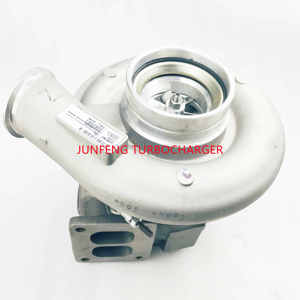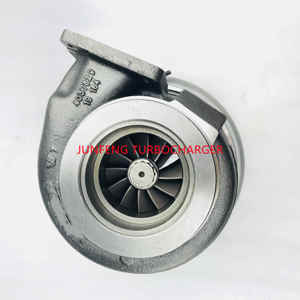(26 products available)



















































































































A 11423083 turbocharger is a forced induction device that uses exhaust gas to spin a turbine, compressing air entering the engine to improve performance. The 11423083 turbochargers are OEM turbochargers utilized in various vehicles and machinery. They don't have standard sizes but come in different sizes depending on the make and model of the car. However, they can be categorized into two main types based on their configuration and design.
Single turbochargers:
Single turbochargers are the most common type of turbocharger and can be found in most vehicles. As the name suggests, this turbocharger has a single turbine and compressor in its housing. The turbine is connected to the engine's exhaust system and spins when the exhaust gases flow through it. The spinning of the turbine forces the compressor blades to spin, drawing in air and forcing it into the engine's intake system. These 11423083 turbochargers can further be divided into various subcategories based on their size and purpose. For instance, there are standard turbochargers that are the most common type and low-pressure turbochargers that provide a small boost to the engine.
Twin turbochargers:
Twin-turbochargers are another type of turbocharger, although less common than single turbochargers. Similar to single turbochargers, these also utilize a turbine and compressor to force more air into the engine and improve performance. However, they have two sets of turbines and compressors instead of one. The twin-turbochargers can also be split into two types: parallel and sequential twin turbochargers. In parallel configurations, each turbocharger compresses air for half of the engine's cylinders. For example, if the engine has six cylinders, one turbocharger will serve three cylinders, and the other will serve three cylinders. In a sequential twin-turbocharger configuration, one smaller turbocharger and one larger turbocharger are used. The smaller turbocharger spools up quickly and provides boost at low engine speeds, while the larger turbocharger provides boost at high engine speeds. The combination of the two turbochargers ensures consistent and smooth power delivery throughout the engine's entire RPM range.
The specifications of the 11423083 turbochargers vary depending on the make and model. They have a standardized way of representing the turbochargers.
Compressor section
The compressor wheel is made of aluminum, and its diameter is 59 mm. The compressor housing is made of cast iron, and its inlet measures 2.1 inches (53 mm) while the outlet measuring 1.8 inches (46 mm). The compressor also has a pressure ratio of 3.6.
Turbine section
The turbine wheel is made of inconel, and its diameter measures 55 mm. The turbine housing is made of cast iron, and its inlet and outlet measure 2.4 inches (61 mm) and 2.0 inches (51 mm), respectively. The turbine has an aspect ratio of 0.79.
Center housing and rotating assembly
The shaft of the turbocharger is made of inconel, and its diameter measures 0.5 inches (13 mm). The bearing is made of bronze, and the bearing housing has a diameter of 1.9 inches (48 mm). The 11423083 turbocharger also uses a water-cooled actuator.
Here are some general maintenance tips for the 11423083 turbocharged engines.
Regular oil changes
Lubrication is very important for the turbocharger. It minimizes wear and tear, helping the engine run smoothly. Using the right oil is important for the turbocharger, so ensure the oil meets the manufacturer's specifications. Also, remember to change the oil regularly to keep the turbo in good shape.
Pre-lube and idle
Before driving, let the engine run for a few minutes to circulate the oil throughout the turbo. This is especially important for high-RPM driving or towing. Also, remember to idle the engine for a few minutes after driving, especially for long periods. It allows the heat to dissipate and prevents oil coking.
Air filter inspection
A clean air filter is essential for the turbo to function properly. It prevents debris from entering the engine and ensures proper airflow. Inspect the air filter regularly and change it every 20,000 miles or as specified by the manufacturer.
Wastegate and actuator check
The wastegate regulates the boost levels to prevent overboosting. Ensure it is functioning properly by checking for boost level issues. Also, inspect the wastegate actuator for any leaks or damage and replace it if necessary.
Boost control and vacuum lines
The boost control and vacuum lines help regulate the boost levels in the engine. Check the lines for cracks, wear, or leaks and replace them if damaged. Ensure all connections are tight to prevent boost level issues.
When buying a 11423083 turbo for resale, there are several factors to consider in order to meet the demands of different customers. Understanding the customer needs is the first step when buying any product. The customer may need a turbocharger for light-duty applications, heavy-duty applications, or even for performance upgrades. 11423083 turbochargers are suitable for all applications. However, it would help to stock different models to cater to various customers' needs. Choose turbochargers that provide quick acceleration and response for performance upgrades. Light-duty applications may also require quick spool-up times. However, for heavy-duty applications, a turbocharger with a large compressor housing would be ideal. Such turbochargers can handle high loads without straining.
Consider the 11423083 turbocharger's A/R ratio. The A/R ratio measures how quickly the turbo spools and how it delivers power. A lower A/R ratio turbo spools quickly but runs out of power quickly. It is ideal for light-duty and performance applications. On the other hand, a turbo with a higher A/R ratio spools slowly but provides more power. It is suitable for heavy-duty applications. Stocking different 11423083 turbochargers with varying A/R ratios allows buyers to find suitable models for their needs.
Another factor to consider is the material. 11423083 turbochargers are made of stainless steel, cast iron, and other durable materials. Those made of cast iron are more heat resistant and durable. They are ideal for heavy-duty applications where the turbocharger is used constantly under high loads. However, turbos made of stainless steel offer faster spool times and corrosion resistance. They are suitable for light-duty and performance upgrades applications.
The 11423083 turbocharger can be water-cooled or oil-cooled. Water-cooled turbos are more efficient and durable. The cooling system helps to cool down the turbocharger quickly after acceleration. However, they are more expensive than the oil-cooled turbochargers.
Buying the 11423083 turbocharger from reputable manufacturers and suppliers is important. Choose suppliers that provide warranties and after-sale services. Consider the cost of the turbochargers and whether they will yield profits.
Many people think that turbochargers are just for fancy sports cars. The truth is, all kinds of vehicles can benefit from a turbocharger. The key is to find the right one for each specific vehicle. Replacing a turbocharger is not an easy task. It requires mechanical knowledge and experience. Below is how to replace the 11423083 turbocharger:
Assemble the right tools:
To replace the turbo, get these tools: socket set, wrench set, torque wrench, gasket scraper, new gaskets, clean rags, etc. Also, read the vehicle's manual to know more about the turbo replacement process.
Prepare the vehicle:
Park the vehicle on a flat surface and set the parking brake. Open the hood and disconnect the battery. Raise the vehicle and secure it on jack stands. Then, remove the front wheels and the wheel liners to access the turbo.
Remove the old turbocharger:
Disconnect the pipes and electrical connections attached to the old turbo. Then, unbolt the turbo from the exhaust manifold and carefully remove it. Also, remove any attached gaskets and clean the mounting surfaces.
Install the new turbocharger:
Position the new turbo onto the exhaust manifold and secure it with bolts. Then, install new gaskets and reconnect the pipes and electrical connections. Follow the manufacturer's torque specifications for tightening the bolts.
Finish the job:
Put back the wheel liners and wheels. Lower the vehicle and reconnect the battery. Start the engine and let it run for a minute. Check for any leaks or unusual noises. Take a test drive to ensure everything is working properly.
Q1: What is the most common problem with the 11423083 turbocharger?
A1: The 11423083 turbocharger is prone to wear and damage. This affects the overall performance and efficiency of the turbocharger. Various factors cause this, such as insufficient lubrication, dirt and debris, manufacturing defects, normal wear and tear, and over-speeding.
Q2: How can people maintain the 11423083 turbochargers?
A2: Proper maintenance is key to increasing the lifespan of the 11423083 turbochargers. Here are a few maintenance tips:
Q3: Can the 11423083 turbo be upgraded?
A3: Yes, the 11423083 turbo can be upgraded. An upgraded turbocharger can result in better airflow, increased boost levels, and improved performance. However, ensure that the new turbo is compatible with the existing engine.
Q4: What is the warranty period for the 11423083 turbocharger?
A4: The warranty period for the 11423083 turbocharger varies depending on the supplier or manufacturer. Typically, the warranty period ranges from 12 months to 36 months. Be sure to check the warranty terms and conditions.